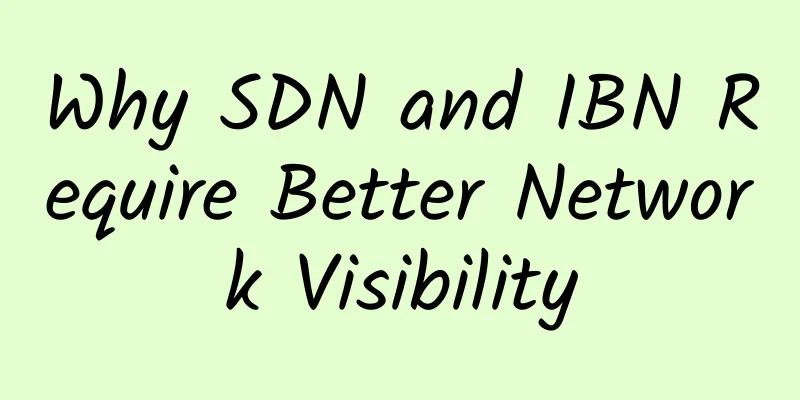Why SDN and IBN Require Better Network Visibility

|
Intent-based networking (IBN) has been a topic of discussion for the past few years. However, network visibility, which plays a key role in the discussion of IBN and SDN adoption, has not been a specific concept. Automation and IBN abstract the underlying complexity of the network, and while these technologies make the network easier to operate, they also reduce the network administrator's understanding of how the system actually works. Without comprehensive network visibility, it is difficult for network operations (NetOps) teams to determine whether their intent-based policies are effective, verify that they are working properly, and gather the insight and understanding needed to troubleshoot IBN issues and failures. IBN allows network administrators to set up settings for the desired network state, and automated network orchestration software will implement these configurations without further human interaction. The idea is not new, but as network automation management becomes more common, IBN is still largely seen as an early technology. But Gartner predicts that IBN will become a "mainstream" technology by 2020.
While the shift to automation in the network has many positives, it also reduces the NetOps team’s understanding of their network. Over the past 30 years, there have been numerous studies on the impact of automation. The results show that when users are no longer immersed in the day-to-day operational tasks of maintaining a system, their understanding of the system decreases. When an automated system fails or errors, the system becomes more difficult to recover. To overcome these challenges, IT and NetOps need to start investing in the next generation of network performance management and diagnostics (NPMD) tools. These solutions are designed to provide insights and visualizations from multiple network data sources to help network operators better understand, manage, and troubleshoot the infrastructure and applications that make up their complex IT environments (IBNs or SDNs). We know that as IBN technology continues to mature and the use of automated systems continues to increase, failures at all levels are inevitable. Some may be caused by human errors in design and development, errors around how the system interprets "intentions" or due to unexpected circumstances. When these failures occur, if operators cannot identify the system failure issue, it takes a long time to fix the problem and restore the system to an operational state. Therefore, network visibility plays a critical role in IBN and SDN planning, management, and troubleshooting. Beyond that, there are other important factors to network visibility. Humans still need to establish the policies that IBN follows. If they don’t understand how the “intent” will affect network and application performance (or other problems it may cause), then how can they be expected to adjust the policy (or intent) correctly? If they can’t monitor the network over time, they won’t know if the automated policy is working as planned. This is especially important because users also need to build trust in their automation. Providing a way to verify and understand policy can help increase trust, thereby increasing the adoption and deployment of IBN. ***, IBN and SDN can create a virtual network architecture, but most traditional network management platforms lack the necessary integration to understand these new structures. This makes end-to-end troubleshooting of application problems difficult because traffic affects the fabric and virtual networks, often creating a black hole for operations. Many SD-WAN vendors offer built-in monitoring solutions, but these solutions only cover their fabric. What NetOps really needs is an end-to-end view of the traffic entering and exiting the multi-vendor environment. Gartner predicts that IBN will initially be deployed in phases, and during this transition period, enterprises will have hybrid networks that are more challenging to manage. As IBN evolves and SDN becomes more widely adopted, NetOps will begin to demand better ways to view, analyze and control the network in order to speed up problem isolation and resolution. Visualizing complex data in a simple, intuitive view provides a more efficient approach. |
<<: Comprehensive popular science about "Internet of Vehicles"!
>>: How to improve Wi-Fi performance: Experts talk planning, troubleshooting
Recommend
In 2018, Huawei invites ecosystem partners to jointly stimulate the unlimited potential of the ecosystem
[51CTO.com original article] At 9:30 am on March ...
Global 6G research focuses on intelligence, collaborative innovation helps the industry upgrade digitally
This is actually just one of the vision goals for...
Why is the 400-MHz spectrum ideal for critical communications?
The 400 MHz spectrum, with its long range, excell...
Akamai Releases 2021 Annual Sustainability Report
March 14, 2022 - Akamai Technologies, Inc. (Akama...
Byte One: The website cannot be displayed, how to troubleshoot?
Hello everyone, I am Xiaolin. A reader was asked ...
Whether to adopt blockchain is always a matter of choice
Blockchain is currently a technology that has att...
Huawei launches intelligent network to unleash the power of ultra-broadband with intelligence
[51CTO.com original article] Hangzhou, China, Oct...
ProfitServer Spanish VPS is now 50% off, with unlimited traffic KVM starting at $2.88 per month
I received an email from ProfitServer, saying tha...
Cool down the false millimeter wave! Adhere to the road of confidence and look at the millimeter wave rationally
Last year, a manufacturer raised a very interesti...
Are the Prague Proposals issued by 32 countries targeting China's 5G? No, there is a new opportunity behind it.
In Prague Square, white doves are facing the suns...
China Mobile's 5G planning goals have been clarified
At the online forum "How to 'accelerate&...
Does eSIM have a big impact on mobile network operators?
The number of cellular Internet of Things (IoT) c...
What is bandwidth management?
Bandwidth management involves the strategic alloc...
DiyVM: Hong Kong CN2, US CN2, Japan Osaka, 2G memory package starting from 50 yuan/month
DiyVM was founded in 2009 and is a Chinese hostin...
The United States has approved 6G trials. Is this a far-sighted move or a desperate attempt?
Recently, US President Trump announced the approv...









